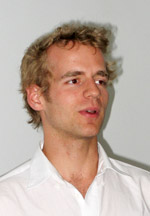 A special talk was delivered at the Wessex Institute of Technology Campus by Sebastian von Mammen of the University of Calgary, Canada, on the topic of “Swarm Grammars – Model, Exploration and Application”.
A special talk was delivered at the Wessex Institute of Technology Campus by Sebastian von Mammen of the University of Calgary, Canada, on the topic of “Swarm Grammars – Model, Exploration and Application”.
Sebastian has a degree in Informatics from the University of Erlangen in Germany and is now completing a PhD at the Department of Computer Sciences, University of Calgary, where he works in the Evolutionary and Swarm Design Group.
Swarm Grammars, Sebastian explained, are presented as novel bio-inspired computational models. Local interactions in a multi-agent environment drive the emergence of three-dimensional structures. The instance space of Swarm Grammars can be explored by different approaches of evolutionary computation. Interacting and Immersive breeding methodologies are utilized to discover aesthetic structures. An automated evolutionary approach is taken to develop functionally creative Swarm Grammar systems that lend themselves to designing architectural idea models.
Swarm models are inspired by the construction behaviour of social insects and allow the building of architectural idea models in virtual 3-D space. Instead of following a blueprint for construction, the individuals of a swarm react to their local environment according to an innate behavioural script. Through the interplay of the swarm with its environment, interaction sequences take place that give rise to complex emergent constructions. The configuration of the swarm determines the character of the emerging architectural models. Sebastian explained that swarms can be bred that meet our expectations through artificial evolution, a very good framework for computationally phased optimisation problems.
Sebastian presented several evolving, swarm-built architectural models and discussed their potential in regards to modern ecological architecture.
The next stage is to incorporate physics and physical measures into the simulation environment; improve on real-world architectural models and breed swarms to optimize architectural ecology. All this will result in new complexity measures for the emerging structures and construction processes.
The lecture was followed by a lively period of discussion which demonstrated the interest in the idea by WIT researchers. The computer methodology proposed by Sebastian could be used to simulate and optimize complex city infrastructures, such as water, energy, traffic, movement of humans and animals.

 Wessex Institute
Wessex Institute